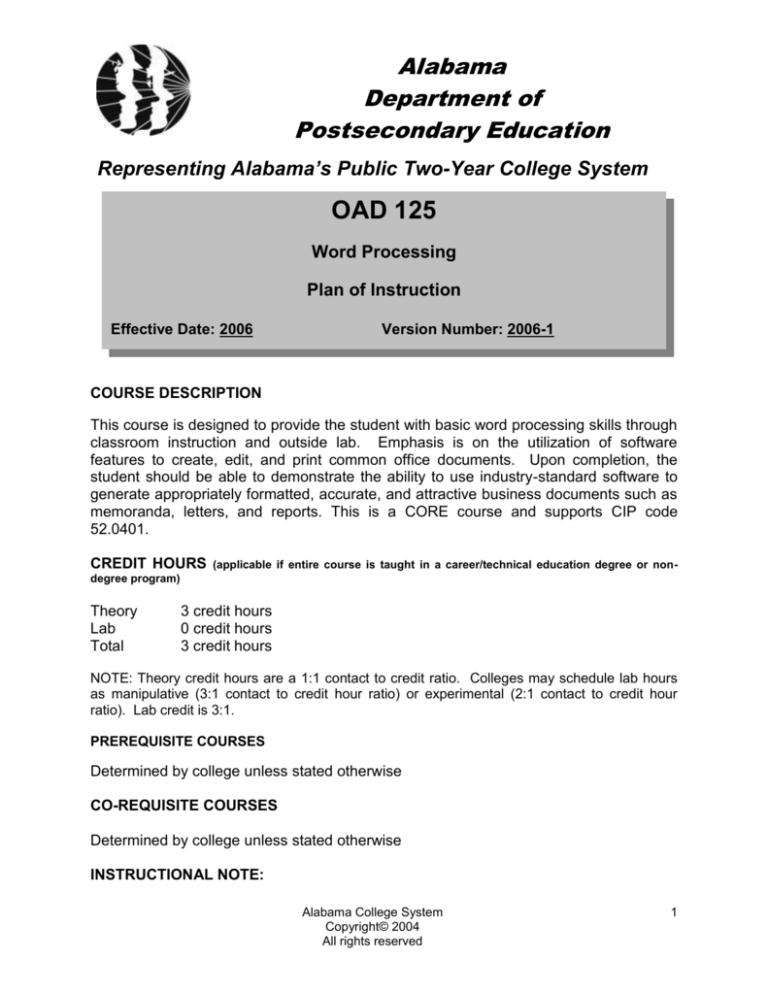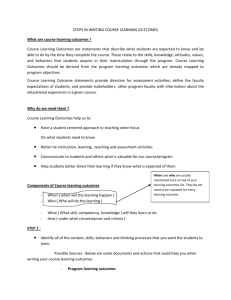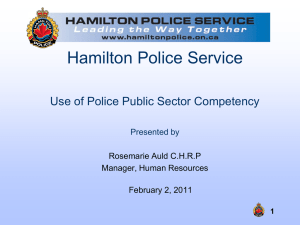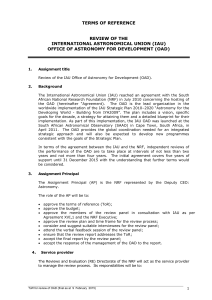
Alabama
Department of
Postsecondary Education
Representing Alabama’s Public Two-Year College System
OAD 125
Word Processing
Plan of Instruction
Effective Date: 2006
Version Number: 2006-1
COURSE DESCRIPTION
This course is designed to provide the student with basic word processing skills through
classroom instruction and outside lab. Emphasis is on the utilization of software
features to create, edit, and print common office documents. Upon completion, the
student should be able to demonstrate the ability to use industry-standard software to
generate appropriately formatted, accurate, and attractive business documents such as
memoranda, letters, and reports. This is a CORE course and supports CIP code
52.0401.
CREDIT HOURS
(applicable if entire course is taught in a career/technical education degree or non-
degree program)
Theory
Lab
Total
3 credit hours
0 credit hours
3 credit hours
NOTE: Theory credit hours are a 1:1 contact to credit ratio. Colleges may schedule lab hours
as manipulative (3:1 contact to credit hour ratio) or experimental (2:1 contact to credit hour
ratio). Lab credit is 3:1.
PREREQUISITE COURSES
Determined by college unless stated otherwise
CO-REQUISITE COURSES
Determined by college unless stated otherwise
INSTRUCTIONAL NOTE:
Alabama College System
Copyright© 2004
All rights reserved
1
Word Processing
OAD 125
This course is designed to teach document preparation skills using word processing.
Word processing tasks in this course teach students how to create, design, format, and
edit professional documents.
INDUSTRY/PROFESSIONAL COMPETENCIES:
Explain the steps required to create, design, save, print, and edit documents
using word processing software.
Describe the requirements for accurately formatting selected documents.
Change views within word processing software and documents.
Manipulate tabs within word processing software and documents.
Accurately use the clipboard feature within word processing software and
documents.
Use the customizing functions for enhancing word processed documents.
Accurately use the Creating Tables feature within word processed documents.
Accurately use other selected (miscellaneous) word processing features.
GENERAL INSTRUCTIONAL OBJECTIVES
The cognitive objective for this course is for each student to comprehend foundational
knowledge of basic word processing skills used in the tasks of creating, designing,
editing, and formatting text.
The performance objective of this course is for each student to apply and demonstrate
knowledge of word processing skills used in this course.
INDUSTRY/PROFESSIONAL COMPETENCIES/STUDENT PERFORMANCE
MODULE A – CREATING, SAVING, PRINTING, AND EDITING DOCUMENTS
INDUSTRY/PROFESSIONAL
COMPETENCIES
A1.0 Explain the steps
required to create,
design, save, print, and
edit documents using
word processing
software. (3c)
STUDENT PERFORMANCE OBJECTIVES
A1.1 Demonstrate proper procedures for creating,
designing, saving, printing, and editing word
processing documents.
Alabama College System
Copyright© 2004
All rights reserved
2
Word Processing
OAD 125
ENABLING OBJECTIVES/KEY INDICATORS
A1.1.1 Explain how to create and design a document using word
processing software
A1.1.2 Explain how to save a document using the Save features
A1.1.3 Explain the process for using the various print features to print a
document
A1.1.4 Explain how to use Print Preview
A1.1.5 Explain the process of editing documents by inserting and deleting
text, selecting text, using overtype/insert modes, and using
undo/redo
Alabama College System
Copyright© 2004
All rights reserved
KSA
Indicator
c
b
b
b
c
3
Word Processing
OAD 125
MODULE B – FORMATTING DOCUMENTS
INDUSTRY/PROFESSIONAL
COMPETENCIES
B1.0 Describe the
requirements for
accurately formatting
selected documents.
(3b)
STUDENT PERFORMANCE OBJECTIVES
B1.1 Demonstrate proper word processing procedures
for formatting documents.
ENABLING OBJECTIVES/KEY INDICATORS
KSA
Indicator
b
B1.1.1 Explain proper procedure for changing fonts
B1.1.2 Explain the proper procedure for applying text formatting features to
documents
B1.1.3 Explain proper procedures for formatting paragraphs
B1.1.4 Explain proper procedure for changing line spacing
B1.1.5 Explain proper procedure for changing paper size
B1.1.6 Explain proper procedure for changing margins
B1.1.7 Explain procedure for changing page orientation
B1.1.8 Explain the procedure for inserting hard page breaks
B1.1.9 Explain the procedure for aligning text horizontally and vertically
b
b
b
b
b
b
b
b
b
MODULE C – CHANGING THE VIEW
INDUSTRY/PROFESSIONAL
COMPETENCIES
C1.0 Change views within
word processing
software and documents
(3b)
STUDENT PERFORMANCE OBJECTIVES
C1.1 Demonstrate proper techniques for changing the
view in word processing documents
KSA
Indicator
ENABLING OBJECTIVES
C1.1.1 Explain proper procedure for changing the views using word processing
software
Alabama College System
Copyright© 2004
All rights reserved
b
4
Word Processing
OAD 125
MODULE D– TABS
INDUSTRY/PROFESSIONAL
COMPETENCIES
D1.0 Manipulate tabs within
word processing
software and
documents. (3c)
STUDENT PERFORMANCE OBJECTIVES
D1.1 Demonstrate proper techniques for using tabs
ENABLING OBJECTIVES
KSA
Indicator
D1.1.1 Explain the process of using the ruler to set tabs
D1.1.2 Explain the process of using the Tabs dialog box
c
c
MODULE E – CLIPBOARD
INDUSTRY/PROFESSIONAL
COMPETENCIES
E1.0 Accurately use the
clipboard feature
within word
processing software
and documents. (3b)
STUDENT PERFORMANCE OBJECTIVES
E1.1 Demonstrate proper usage of the clipboard features
ENABLING OBJECTIVES
KSA
Indicator
E1.1.1 Explain the process of working with blocks of text
E1.1.2 Explain the process of deleting, moving, copying, and cutting and pasting
text
b
b
Alabama College System
Copyright© 2004
All rights reserved
5
Word Processing
OAD 125
MODULE F – CUSTOMIZING DOCUMENTS
INDUSTRY/PROFESSIONAL
COMPETENCIES
F1.0 Use the customizing
functions for enhancing
word processed
documents. (3b)
STUDENT PERFORMANCE OBJECTIVES
F1.1 Demonstrate proper use of features for customizing
documents
ENABLING OBJECTIVES
F1.1.1 Explain the process of using headers and footers
F1.1.2 Explain the process of using page numbering in a document
F1.1.3 Explain the process of the find/replace features
b
b
b
MODULE G – TABLES AND CHARTS
INDUSTRY/PROFESSIONAL
COMPETENCIES
G1.0 Accurately use the
Creating Tables and
Charts features within
word processed
documents. (3b)
STUDENT PERFORMANCE OBJECTIVES
G1.1 Demonstrate proper use of word processing
features to produce tables and charts
KSA
Indicator
ENABLING OBJECTIVES
G1.1.1 Explain the procedure for creating tables
G1.1.2 Explain the procedure for formatting tables
G1.1.3 Explain the procedure for converting text to table
B
B
B
MODULE H - OTHER MISCELLANEOUS FEATURES
OUS FEATURES
Alabama College System
Copyright© 2004
All rights reserved
6
Word Processing
INDUSTRY/PROFESSIONAL
COMPETENCIES
H1.0 Accurately use other
selected
(miscellaneous) word
processing features.
(3b)
OAD 125
STUDENT PERFORMANCE OBJECTIVES
H1.1 Demonstrate proper use of other miscellaneous
word processing features
ENABLING OBJECTIVES
KSA
Indicators
H1.1.1 Explain other miscellaneous word processing features
b
Alabama College System
Copyright© 2004
All rights reserved
7
Word Processing
OAD 125
COURSE CONTENT OUTLINE
MODULE A – CREATING, SAVING, PRINTING, AND EDITING DOCUMENTS
USING WORD PROCESSING
Creating a document using word processing
Saving a Document
- Save vs. Save As
- Save as Web Page
Printing a Document
- Using the print features
- Print Preview
- Printing Specific Text or Pages
Editing a Document
- Inserting and deleting text
- Selecting text
- Using Overtype/Insert modes
- Undo/Redo
MODULE B – FORMATTING DOCUMENTS
Changing Fonts
- Using Font Dialog Box
Using toolbar to change font and font effects
Formatting Miscellaneous Text Features
- Changing Text Case
- Inserting Date and Time
- Inserting Special Characters
- Creating Ordinals
- Bold, Italics, Underline
Formatting Paragraphs
- Changing the Alignment of Text in Paragraphs
- Spacing Before and After Paragraphs
- Creating Numbered and Bulleted Paragraphs
* Changing the numbering format
* Changing the bullet style
Changing Line Spacing
Changing Paper size
Changing Margins
Alabama College System
Copyright© 2004
All rights reserved
8
Word Processing
OAD 125
* Left and Right Margins
* Top and Bottom Margins
* Gutter Margins
Changing Page Orientation
* Portrait
* Landscape
Inserting Hard Page Breaks
Horizontal and Vertical Alignment of Text
MODULE C CHANGING THE VIEW
- Changing the View
* Normal/Draft View
* Print Layout/Page Mode View
* Web Layout View
* Reading Layout View
* Outline View
MODULE D MANIPULATING TABS
- Using the Ruler to set tabs
- Using the Tabs Dialog Box
* Setting Tabs
* Deleting Tabs
* Tab Alignment
* Clearing Tabs
* Setting Leader Tabs
MODULE E USING THE CLIPBOARD
- Working with blocks of text
* Deleting a block of text
* Moving a block of text
* Copying a block of text
* Cutting and pasting text
MODULE F CUSTOMIZING DOCUMENTS
Creating Headers and Footers
- Using Header/Footer toolbar
* Formatting headers and footers
* Deleting headers and footers
* Creating a header/footer for odd/even pages
Alabama College System
Copyright© 2004
All rights reserved
9
Word Processing
OAD 125
Inserting Page Numbering in a Document
* Deleting Page Numbering
* Modifying Page Numbering Format
Finding and Replacing Text
* Finding text
* Replacing text
* Finding and replacing formatting
MODULE G TABLES
Creating a Table
- Open tables
- Grid tables
- Entering text in cells
- Moving insertion point within a table
- Selecting cells
Formatting a Table
* Adding Borders and Shading
* Changing Column Width
* Changing Table Size with the Resize Handle
* Changing Row Height
* Changing Cell Alignment
* Vertically and Horizontally Aligning a Table
* Inserting columns and rows
* Deleting cells, columns, and rows
* Merging and splitting cells
* Formatting with AutoFormat
* Removing borders
* Moving a table
Converting Text to Table
MODULE H OTHER MISCELLANEOUS FEATURES
Other miscellaneous word processing features
Alabama College System
Copyright© 2004
All rights reserved
10
Word Processing
OAD 125
LEARNING OBJECTIVES TABLE OF SPECIFICATIONS
The table of specifications below identifies the percentage of objectives at a cognitive
level for each module. Instructors should develop sufficient numbers of test items at
the appropriate level of evaluation.
ENABLING OBJECTIVES TABLE OF SPECIFICATIONS
Cognitive Domain
Facts/
Nomenclature
A/a
Module A
Module B
Module C
Module D
Module E
Module F
Module G
Module H
Principles/
Procedures
B/b
60%
100%
100%
Analysis/
Operating
Principles
C/c
40%
Evaluation/
Complete
Theory
D/d
100%
100%
100%
100%
100%
Alabama College System
Copyright© 2004
All rights reserved
11
Word Processing
OAD 125
Performance
Ability
Knowledge, Skills, and Abilities (KSA) Indicators
Value
Key Word(s)
4
Highly
Proficient
3
Proficient
2
Knowledge
Knowledge of
Skills
1
d
c
Partially
Proficient
Limited
Proficiency
Complete
Theory
Operating
Principles
b
Procedures
a
Nomenclature
D
Evaluation
C
Analysis
B
Principles
A
Facts
Definition
Can do the complete competency quickly and
accurately. Can tell or show others how to do the
competency.
Can do all parts of the competency. Needs only a spot
check of completed work
Can do most parts of the competency. Needs help only
on hardest parts.
Can do simple parts of the competency. Needs to be
told or shown how to do most of the competency.
Can predict, isolate, and resolve problems about the
competency
Can identify why and when the competency must be
done and why each step is needed.
Can determine step-by-step procedures for doing the
competency.
Can name parts, tools, and simple facts about the
competency.
Can evaluate conditions and make proper decisions
about the subject.
Can analyze facts and principles and draw conclusions
about the subject.
Can identify relationship of basic facts and state general
principles about the subject.
Can identify basic facts and terms about the subject
Alpha Scale Values - Any item with an upper case letter (A, B, C, D) by itself is taught as general
information on a topic. This information may be related to the competency or encompass multiple
competencies. Examples might include mathematical computations or knowledge of principles such as
Ohm’s Law.
A lower case letter indicates a level of ”Knowledge of Skills." Individuals are taught information pertaining
to performing a competency . These may be indicated alone or in conjunction with a numerical scale value.
A lower case letter by itself indicates the individual is not required to perform the task-just know about the
task. (Example: Can state or explain procedures for doing a task).
Numerical Scale Values - The numbers reflect the levels the individual will be able to perform a
competency. Number values are always accompanied by lower case letters (i.e. 1a, 2b, 3c...etc.) in order to
specify the level of knowledge of skills associated with the competency.
Example: An individual with a competency with a scale indicator of 3b has received training of knowledge of
skills whereby he or she can determine the correct procedures and perform with limited supervision; only
requiring evaluation of the finished product or procedure.
NOTE: Codes indicate terminal values.
Alabama College System
Copyright© 2004
All rights reserved
12
Word Processing
OAD 125
RECOMMENDED INSTRUCTIONAL METHODOLOGIES: The table below links the teaching
methods and activities most effective for facilitating student achievement of learning outcomes
published in this plan of instruction.
Cognitive Level
Goal for Students Teaching Methods
Teaching Activities
(Thinking)
Knowledge
Descriptive Verbs:
Defines, Lists, States,
Describes, Identifies
Comprehension
Descriptive Verbs:
Describe, Explains,
Summarizes
Knows common
terms, specific facts,
methods, procedures,
basic concepts,
principles
Understands facts
and principles
Interprets verbal
material
Interprets charts and
graphs
Lecture
Computer-based
Instruction
Video
Demonstration
Informal Lecture
Discussion
Demonstration
Participation
Interactive Computer
Based Instruction
Mnemonics
Examples or Illustrations
Repetition
Summaries
Reviews
1. Teach to the Knowledge
Level
2. Explains and
demonstrates concept,
principle or procedure
learned
3. Put students in new
situation, and instructor
and students co-solve
employing the indicated
concept, principle, or
procedure.
Translates verbal
material to
mathematical
formulas
Estimates future
consequences
4. Put students in a new
situation, and the students
solve the new situation
using the concept,
principle, or procedure
while instructor
supervises.
Justifies methods and
procedures
5. Remediate/Reteach as
required
Application
Descriptive Verbs:
Uses, Solves, Operates,
Produces,
Demonstrates,
Constructs
Applies concepts and
principles to new
situations
Applies laws and
theories to practical
situations
Demonstration
Individual Research
Lab Exercises
Case Studies
Experiments
Clinicals
Solves mathematical
problems
4. Remediate/Reteach as
required
Demonstrates correct
usage of a method or
procedure
Mechanism
Descriptive Verbs:
Assembles, calibrates,
inserts, removes,
constructs, measures,
fixes, dismantles,
sketches
Goal for Students
2. Teach to the
Comprehension Level
3. Student must identify the
concept, principle, or
procedure and use it to
solve new scenario(s)
Constructs charts,
graphs, or simple
mechanisms
Psychomotor Level
(Doing)
1. Teach to the Knowledge
Level
Teaching Methods
Learned responses
Lab Exercises
have become habitual Case Studies
Alabama College System
and can be performed Experiments
Copyright© 2004
with some confidence
All rights reserved
and proficiency as
designated by the
KSAs
Teaching Activities
1. Demonstration
13
2. Observation
3. Evaluation
4. Feedback
5. Remediate/Reteach as
required
Word Processing
OAD 125
Glossary of Terms
Plan of Instruction (POI)
A teaching-learning plan which includes student centered
instructional objectives, outlined content, instructional and
evaluation strategies, and other relevant information needed to
guide the development and/or revision of learning experiences such
that students achieve stated educational and performance
outcomes.
Industry/Professional
Competencies
A major task that individuals perform in a given industry or
profession . From these major tasks, performance objectives can
be developed. Meeting performance objectives indicates a student
has attained the associated industry/professional competencies.
Taken together, these support the Course Instructional Objectives.
Course Instructional
Objectives
The overall goal of the course of instruction stated in broad terms.
This is supported by the attainment/completion of the competencies
and associated competency tasks and sub-tasks.
Task
A skill that individuals perform that enables them to accomplish and
satisfactorily complete/attain as given competency.
Student Performance
Objectives
The skills each student is required to demonstrate during or at the
conclusion of each module or course. These skills are the direct
result of the attainment/completion of the professional
competencies.
Enabling Objectives/Key
Indicators
The required knowledge and/or skill each student must acquire in
order to have the best chance of achieving the stated Student
Performance Objective.
Knowledge, Skills, and
Abilities (KSA) Indicator
A table that provides an alpha/numeric indicator of knowledge,
knowledge of skills, and performance ability(s) students must
demonstrate at the conclusion of specified instruction. Each
competency designates the terminal level of KSA students must
achieve. Enabling objectives/Key Indicators have a separate KSA
designating the level of knowledge students must have in order to
perform the associated competency(s).
Modules
A grouping of interrelated knowledge and skills representing a subtask of a course. Modules may be taught independently of other
course content.
Prerequisite Courses
Instructional Note
Courses students are required to successfully complete before
being allowed entrance into other courses
Knowledge and skills relevant to the course that students will be
demonstrating during the course. For example: computer, technical
writing, mathematics, and speaking skills.
Alabama College System
Copyright© 2004
All rights reserved
14
Word Processing
Course Prefix/numbers
Co-requisite Course
Modules
Course Content Outline
Contact/Credit hours
Prerequisite Knowledge
Recommended Methods
of Evaluation
Recommended
Instructional
Methodologies
Course Prefix/numbers
Co-requisite Course
Modules
Course Content Outline
Contact/Credit hours
Prerequisite Knowledge
Recommended Methods
of Evaluation
Recommended
Instructional
Methodologies
OAD 125
GLOSSARY OF TERMS (Cont)
Used to identify courses taught in multiple disciplines.
Course required in conjunction to the specified course often in the
form of a lab
A grouping of interrelated knowledge and skills representing a subelement of a course.
A listing of topics for instruction in a particular course
Specifies the recommended contact to credit hours for each course.
Mandates the total credit hours awarded for each course.
Intellectual capabilities required for handling the academic rigors of
the discipline.
Suggests test item options for measuring student achievement of
enabling objectives. Suggests the number of test items required to
adequately measure student achievement of enabling objectives.
Mandates the evaluation of criterion objectives.
Suggests the most effective instructional methods for achieving
stated learning levels
Used to identify courses taught in multiple disciplines.
Course required in conjunction to the specified course often in the
form of a lab
A grouping of interrelated knowledge and skills representing a subelement of a course.
A listing of topics for instruction in a particular course
Specifies the recommended contact to credit hours for each course.
Mandates the total credit hours awarded for each course.
Intellectual capabilities required for handling the academic rigors of
the discipline.
Suggests test item options for measuring student achievement of
enabling objectives. Suggests the number of test items required to
adequately measure student achievement of enabling objectives.
Mandates the evaluation of criterion objectives.
Suggests the most effective instructional methods for achieving
stated learning levels
Alabama College System
Copyright© 2004
All rights reserved
15









